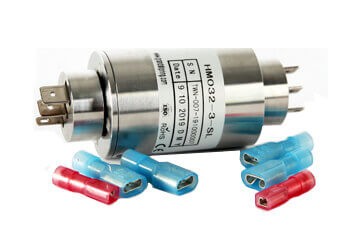In today’s fast-paced industrial landscape, innovative components and devices are critical to maintaining the efficiency and reliability expected of modern equipment. One such device, the mercury slip ring, plays a vital role in facilitating the seamless transfer of electric signals, data, and power between stationary and rotating parts, amidst various mechanical systems. Their unique design, low electrical resistance, and exceptional performance have made them indispensable across a wide range of industries, such as aerospace, robotics, medical devices, and renewable energy. In this comprehensive guide, we will delve into the fundamentals of mercury slip rings, touching on their types, features, applications, and relevant safety precautions to ensure their proper utilization and maintenance.
The Basics of Mercury Slip Rings
What is a Mercury Slip Ring?
A mercury slip ring, occasionally referred to as a mercury-wetted slip ring or a liquid metal slip ring, is a type of electrical connector designed to facilitate the flow of electric signals or power between a stationary source and a component that is in continuous rotation.
This function is indispensable in a variety of machinery where unrestricted, 360-degree rotation is paramount while maintaining power supply or data transfer. As the name suggests, these slip rings employ mercury (a conductive liquid metal) as the contacting material. Rather than using conventional brush systems found in standard slip rings, they create an electrical path using pools of mercury wherein the conducting pin dips.
The unique configuration bestowed by the mercury allows these slip rings to operate with extremely low electrical resistance. This in turn aids in providing strong signal integrity, which translates into minimal signal loss or distortion, making them highly efficient for transmitting sensitive data or carrying out high-precision tasks. Furthermore, due to the absence of mechanical wear and tear typically associated with traditional brush and contact-ring systems, mercury slip rings exhibit prolonged operational lifespan and contribute to low-maintenance operations in diverse industrial environments.
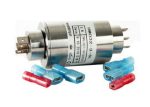
How Mercury Slip Rings Work
- Electrical Conductivity: Mercury is used because it remains in liquid form at room temperature and has excellent electrical conductivity.
- Contact with Mercury: As the rotating shaft turns, electrical contacts in the rotating part dip into the mercury pool.
- Continuous Connection: The liquid mercury forms a continuous, low-resistance electrical path between the rotating and stationary contacts.
- Signal/Powers Transfer: Electrical signals or power can then be transferred from the stationary part to the rotating part (or vice versa) through the mercury.
Applications of Mercury Slip Rings
Mercury slip rings offer a broad range of advantages, making them a sought-after solution for various applications across multiple industries. Their noteworthy benefits, along with the ability to provide uninterrupted electrical connections, contribute to their widespread use in the following sectors:
- Aerospace and defense: In radar systems, satellites, and other aeronautical equipment where rotational movement and high-reliability signal transmission are crucial, mercury slip rings present an ideal choice.
- Robotics and automation: Industrial robots and automated machinery require continuous power supply and data transfer for accurate, efficient, and coordinated actions. Mercury slip rings ensure these functions run smoothly without interruption.
- Medical equipment: In medical imaging systems such as CT scanners and MRI machines, powerful and reliable electrical connections combined with uninterrupted movement allow for precise diagnostics.
- Wind turbines: Wind turbines require slip rings to transfer power generated by the moving blades to stationary components. The low-maintenance and high-performance attributes of mercury slip rings make them an excellent fit for this application.
- Packaging machines: Packaging machines rely on rapid, precise rotations for filling, sealing, and labeling products. Mercury slip rings facilitate the necessary electrical connections, enhancing overall efficiency and output.
- Marine systems: Shipboard navigation, communication, and control systems often necessitate continuous electrical connections while adapting to harsh environments. Mercury slip rings offer robust performance, low maintenance, and corrosion resistance in such circumstances.

The benefits of using mercury slip rings include:
- Minimal maintenance: The absence of intermittent brushes eliminates brush wear, leading to reduced downtime and extended service life.
- Low electrical noise and high signal integrity: These slip rings ensure optimal signal transmission, even in environments where high precision or sensitive data transfers are necessary.
- Long operational lifespan: Their robust design and absence of parts prone to wear contribute to an extended operational lifespan, enhancing their overall efficiency and cost-effectiveness over time.
- High rotational speeds and compact designs: Mercury slip rings offer excellent performance even at high rotation speeds, while their compact design allows them to fit into tight spaces, maximizing their applicability across diverse settings.
The combination of the identified industries, applications, and benefits paints a coherent picture of the importance of mercury slip rings in modern contexts. This reliable solution simplifies the often cumbersome challenge of maintaining electrical connections within rotating systems, ensuring consistent performance in various installations and applications.
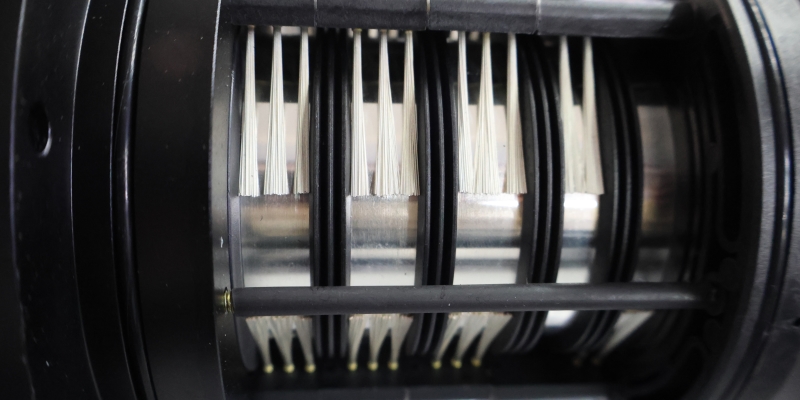
Types of Mercury Slip Rings
Rotary Joint Mercury Slip Rings
Rotary joint mercury slip rings, also known as rotary interface mercury slip rings, are engineered to create an efficient, reliable, and continuous electrical connection across rotating interfaces. These slip rings comprise a stationary component and a rotating component, with the stationary part housing mercury reservoirs that form the connection with the rotating component’s contact pins. As the rotating member turns, the immersed pins ensure steady contact with the mercury, thereby maintaining the electrical path.
Designed for high-performance rotation, these slip rings can withstand a wide range of rotational speeds without compromising on the transmission quality. They are constructed to support the intricate and demanding requirements encountered in demanding industries and specific applications, such as:
- Robotics: Rotary joint mercury slip rings are well-suited for robotic joints and robotic arms where continuous power supply, precise control, and high-speed rotation are vital for seamless operation.
- Automation systems: In various automation equipment like pick-and-place machines, rotary indexers, and automated assembly lines, these slip rings guarantee reliable power and data transfer, ensuring high efficiency and accuracy.
- Rotating platforms: Be it military applications, radar systems, or communication antenna systems, the rotational interfaces require a steady flow of power and data. Rotary joint mercury slip rings help maintain this continuity, even during constant rotational motion.
The adoption of rotary joint mercury slip rings enhances the overall system performance and reliability. They significantly contribute to the efficient operation of connected equipment and machinery, which in turn, impacts the industries that rely on these applications.
Capsule Mercury Slip Rings
Capsule mercury slip rings are a specialized variant of mercury slip rings, characterized by their compact design and protective enclosure. These slip rings comprise a capsule-shaped housing that encases the slip ring assembly, including the mercury reservoirs and contact pins. The sealed environment protects the slip ring’s internal components from external contaminants, moisture, or debris, allowing it to function reliably even under challenging operating conditions.
The small size and lightweight nature of capsule mercury slip rings enable them to fit into areas where space is limited or intricate installation is required. As a result, they prove to be a valuable asset in a multitude of applications, including:
- Medical devices: Capsule mercury slip rings are found in various medical devices such as X-ray machines and dental equipment where they facilitate precise movement and require minimal maintenance, ensuring accurate diagnostics and uninterrupted functionality.
- Camera systems: In surveillance equipment or gimbal stabilization systems that require 360-degree rotation, capsule mercury slip rings facilitate continuous power supply and data transmission for clear, unobstructed visuals.
- Miniature rotating systems: Small-scale rotating equipment like rotary sensors, index tables, and tabletop displays benefit from the compact design and efficient performance of capsule mercury slip rings.
The incorporation of capsule mercury slip rings into these specific applications significantly contributes to the overall functionality and performance of the respective devices. Their unique design allows them to cater to a diverse set of applications where traditional slip rings or large mercury slip rings cannot be utilized, emphasizing their value in addressing a plethora of space and application constraints.

Mercury Slip Rings: Key Features
Electrical Properties
Mercury slip rings exhibit highly efficient electrical properties which foster their widespread application across various industries:
- Electrical Conductivity and Resistance: Employing mercury as the conductive medium, these slip rings feature excellent electrical conductivity, facilitating efficient signal and power transmission. They exhibit low electrical resistance, leading to minimized energy loss during transmission and helping uphold the integrity of the transferred signals.
- Voltage and Current Rating: Mercury slip rings accommodate a wide range of voltage and current ratings to meet diverse application requirements. The specific capacity depends on the manufacturer and the intended use, but typically, they are designed to handle anything from low voltage signals (for data transfer in communications equipment) to high currents (for power transmission in industrial machinery).
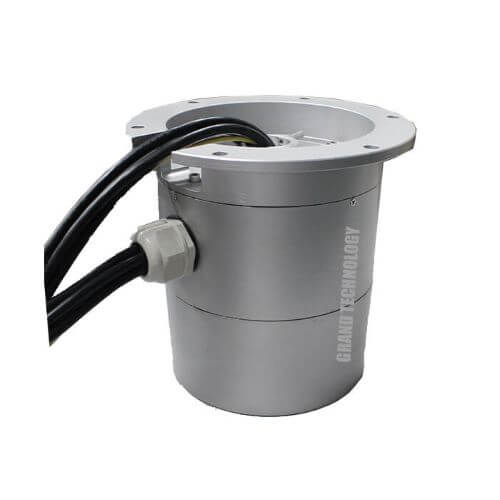
Mechanical Properties
The mechanical specifications of mercury slip rings play a defining role in their operational performance:
- Load Capacity and Rotation Speed: Ranging from less demanding applications like small surveillance cameras to high-load situations like industrial robotic arms, mercury slip rings can be designed to withstand different load capacities. Additionally, they provide consistently reliable transmission, even at varied rotation speeds, without compromising on signal quality.
- Operating Temperature and Environmental Factors: Mercury slip rings generally possess a wide operating temperature range, often found within -20°C to +60°C. However, specific ranges can be application-dependent. They also tend to be resistant to certain environmental factors such as mild contaminants or oxidative agents, thanks to the use of sealed or enclosed designs.
Reliability & Durability
The reliability and durability of mercury slip rings are significant considerations in determining their long-term performance:
- Lifespan and Maintenance Requirements: Owing to the absence of mechanical wear-and-tear (such as brush wear), mercury slip rings generally boast a long operational lifespan with minimal maintenance requirements. Regular inspections and checks ensure optimal functioning but without the necessity for frequent replacements, as seen in traditional slip rings.
- Manufacturer Warranties and Certifications: Most reputable manufacturers substantiate the quality of their mercury slip rings via warranties, which act as a guarantee against premature failure or defects. Models may also come with certifications, such as ISO standards or UL listings, signifying adherence to globally recognized standards for safety, quality, and performance.
The amalgamation of these electrical, mechanical, and reliability properties helps to paint a comprehensive image of the critical features and specifications of mercury slip rings. It exemplifies how they are engineered to deliver optimal performance reliably over an extended period, meeting the evolving demands and enhancing the efficiency of a multitude of applications and industries.
Mercury Slip Rings Specifications
Mercury slip rings come with various specifications tailored to different applications. Below are some common specifications and parameters you might encounter:
Common Specifications
- Number of Circuits: The number of separate electrical channels or circuits the slip ring can accommodate. This can range from a few to several dozen circuits.
- Current Rating: The maximum current each circuit can carry, typically measured in amperes (A). Common ratings might include 2A, 5A, 10A, or higher for specialized applications.
- Voltage Rating: The maximum voltage that can be safely applied to the slip ring, usually specified in volts (V). This could range from a few volts to several hundred volts.
- Signal Types: The types of electrical signals the slip ring can handle, such as analog, digital, power, Ethernet, or high-frequency signals.
- Operating Speed: The maximum rotational speed, often measured in revolutions per minute (RPM). Typical values might range from a few hundred to several thousand RPM.
- Temperature Range: The operational temperature range within which the slip ring can function effectively. This might be specified in degrees Celsius (°C) or Fahrenheit (°F).
- Contact Resistance: The resistance of the contacts in the slip ring, usually measured in milliohms (mΩ). Lower contact resistance is desirable for efficient electrical transfer.
- Insulation Resistance: The resistance between the electrical circuits and the housing, typically measured in megaohms (MΩ). Higher insulation resistance indicates better isolation and safety.
- Housing Material: The material of the slip ring housing, which can affect durability and environmental resistance. Common materials include aluminum, stainless steel, and various plastics.
- Ingress Protection (IP) Rating: The degree of protection against dust and water ingress. Higher IP ratings indicate better protection, such as IP65, IP67, etc.
- Dimensions and Weight: Physical dimensions (diameter, length) and weight of the slip ring, which are important for integration into systems.
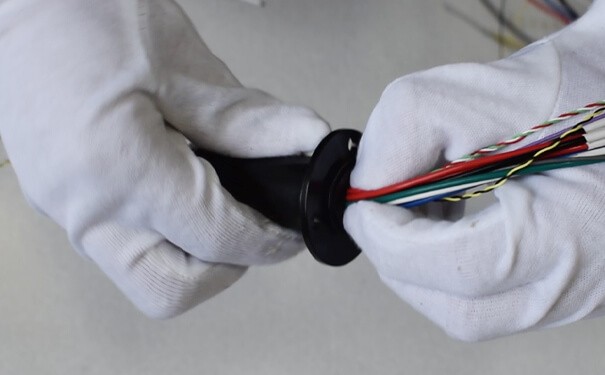
Example Specification Table
| Parameter | Range |
|---|---|
| Current Capacity | 2A – 500A |
| Voltage Rating | 24V – 1000V AC/DC |
| Rotational Speed | 300 – 10,000 RPM |
| Operating Temperature | -50°C to +150°C |
| IP Rating | IP54 – IP68 |
| Data Protocols | Ethernet, USB, CANbus, Fiber Optics |
| Insulation Resistance | 100 MΩ @ 500V DC |
| Contact Technology | Gold-on-Gold, Silver Brushes |
| Fiber Optic Loss | ≤0.5 dB per pass |
| Fluid Channel Pressure | Up to 20 bar |
| Life Span | 10 – 100 million revolutions |
Many manufacturers offer customization options to meet specific application requirements, such as different circuit configurations, higher current or voltage ratings, and specialized housing materials or coatings for extreme environments.
Caution of Using Mercury Slip Rings
Mercury slip rings, which are used in electrical systems to provide a continuous electrical connection between rotating and stationary parts, have some specific cautions associated with their use:
- Health and Safety Risks: Mercury is toxic and can pose serious health risks if proper precautions are not taken. Exposure to mercury vapor or spills can be harmful. Always handle mercury with care, use appropriate personal protective equipment (PPE), and ensure proper ventilation in the work area.
- Environmental Concerns: Disposal of mercury-containing components must follow strict regulations to prevent environmental contamination. Ensure that any mercury-containing components are disposed of in accordance with local hazardous waste disposal guidelines.
- Maintenance and Reliability: Mercury slip rings can be prone to wear over time. Regular maintenance is essential to ensure reliable operation. Periodic inspections for signs of wear or contamination can help prevent failures.
- Operational Limitations: Mercury slip rings may not be suitable for all applications. They are typically used in specific environments where their characteristics are beneficial, but alternatives such as solid-state slip rings or other types of mechanical contact rings may be more appropriate depending on the application.
- Cost: The use of mercury slip rings can be more expensive due to the need for specialized handling and disposal procedures. Consider the cost-benefit analysis compared to other types of slip rings.
In summary, while mercury slip rings can be effective in certain applications, their use requires careful consideration of health, environmental, and maintenance issues.
Mercury Slip Rings: Selection & Installation Considerations
How to Choose the Right Mercury Slip Ring
Selecting an appropriate mercury slip ring for a particular application requires careful consideration of various factors. The following guidelines and criteria can help in making a well-informed decision:
- Determine the voltage and current requirements: Analyze your application’s voltage and current needs, and choose a slip ring that can cater to these requirements without surpassing its rated capacity.
- Consider the rotational speed: Assess the rotational speed at which the slip ring will operate, ensuring it can deliver reliable performance at the given speeds without any reduction in efficiency or deterioration of signal quality.
- Evaluate the number of circuits: Ascertain the number of distinct electrical circuits that need to pass through the slip ring, keeping in mind the required separate power and signal pathways to avoid interference.
- Understand mechanical constraints: Account for the space limitations, mo
- unting configurations, and load capacities in your specific application, ensuring the selected mercury slip ring is suitable in terms of size and mechanical properties.
- Assess the environment: Consider the slip ring’s exposure to external contaminants, moisture, temperature fluctuations, or other environmental factors in your application and opt for a model that can withstand these conditions.
- Budget and maintenance considerations: Compare the available options within your budget constraints, factoring in not only initial costs but also long-term maintenance requirements and replacement schedules.
Installation Tips & Best Practices
Proper installation is crucial for optimizing the performance of mercury slip rings. Follow these guidelines and precautions while installing:
- Read the manufacturer’s manual: Begin by reviewing the manufacturer’s installation instructions and technical specifications to ensure optimal compatibility with your application.
- Ensure a clean installation environment: During installation, maintain a clean work environment to prevent dust, debris, or contamination from compromising the integrity of the slip ring’s connections.
- Proper mounting: Ensure the slip ring is securely mounted and correctly aligned with the rotating and stationary elements. Misalignment can result in inefficient signal transmission or premature wear.
- Correct wiring: Connect the wires and cables as instructed in the manual, guaranteeing proper insulation and shielding to prevent short circuits, crosstalk, or electromagnetic interference.
- Test and monitor: Once installed, perform a thorough test of the slip ring’s functionality and monitor its performance, especially during the initial phase of operation, to identify any potential issues.
Common installation issues and their troubleshooting tips:
- Poor connection or signal transmission: Check for loose connections, damaged cables, or incorrect wiring. If the problem persists, consult with the manufacturer for further guidance.
- Mechanical noise or vibrations: Investigate alignment and secure mounting to ensure smooth operation. If necessary, refer to the manufacturer’s manual or seek technical assistance.
- Excessive heating or wear: Verify the ambient temperature, load capacity, and operating conditions to ensure the slip ring is not operating outside its specified range.
Considering these selection and installation aspects helps ensure that the chosen mercury slip ring will provide reliable performance throughout its lifespan. Proper evaluation, installation, and monitoring practices contribute to unhindered operation, enhancing the overall efficiency and value offered by the mercury slip ring to the respective application and industry.
Interested in Our Mercury Slip Rings? Contact Us for Pricing and Technical Specifications!
Mercury Slip Rings: Safety & Environmental Concerns
Safety Guidelines
Working with mercury slip rings entails specific precautions and safety measures to ensure a secure environment:
- Proper Handling: Handle the slip rings with care to prevent any accidental drops or impacts that could damage the unit or disrupt the mercury reservoirs.
- Avoid Exposure: Mercury is toxic, and exposure can lead to serious health complications. Never attempt to open or repair a mercury slip ring without proper training and understanding of the risks involved.
- Prevent Shock Risks: As these units conduct electricity, take proper precautions to prevent electric shock. Avoid touching the terminals when the device is in operation.
- Train Staff: Ensure anyone working with or around mercury slip rings is aware of the potential risks and knows how to act in case of emergencies.
- Use Protection Gear: Depending on the specific application and work environment, protective gear such as gloves, safety glasses, and sometimes even full protective suits should be worn to minimize any risks.
Environmental Impact & Proper Disposal
Mercury, despite its functionality in slip rings, is a heavy metal that poses significant environmental concerns:
- Environmental Concerns: If improperly disposed of, mercury can contaminate water sources and enter the food chain, causing harm to wildlife and potentially humans. It’s, therefore, crucial to manage and dispose of mercury and mercury-containing products responsibly.
- Responsible Disposal Methods: Mercury slip rings at the end of their lifespan should never be disposed of in regular trash. They must be taken to a certified electronics recycling facility or a hazardous waste disposal site that can handle mercury. Local laws and regulations dictate the exact disposal methods and these should be strictly adhered to.
- Recycling and Waste Management: Many manufacturers and organizations offer recycling programs or take-back schemes for their products. When deciding to replace a mercury slip ring, contact the manufacturer or distributor to enquire if they offer such programs.
Understanding and prioritizing safety and environmental considerations are important parts of working with mercury slip rings. Ensuring safe practices, wearing proper protective gear, and adhering to appropriate waste management protocols not only protect the individuals involved but also contribute positively to the wider environmental preservation efforts.
Concerns About Mercury Slip Rings
Mercury slip rings, while offering certain advantages, also come with significant concerns that need to be carefully considered:
Health and Environmental Concerns
- Toxicity: Mercury is highly toxic to humans and animals. Exposure can cause severe health issues, including neurological and organ damage. Proper handling and disposal are critical to prevent mercury poisoning.
- Environmental Impact: Mercury can contaminate water sources and ecosystems, causing long-term environmental damage. Disposal of mercury slip rings must follow strict environmental regulations to prevent leakage and contamination.
Safety Concerns
- Leakage Risk: Mercury slip rings must be hermetically sealed to prevent mercury leakage. Any breach in the seal can result in toxic spills, posing risks to both health and the environment.
- Handling and Maintenance: Special precautions and equipment are needed to handle mercury slip rings safely, including protective gear and proper ventilation. Maintenance can be hazardous due to the risk of mercury exposure.
Technical Concerns
- Temperature Sensitivity: Mercury’s properties can change with temperature fluctuations. Extreme temperatures may affect the performance of the slip ring, requiring careful monitoring and control of operating conditions.
- Electrical Noise and Interference: While mercury slip rings are designed to minimize electrical noise, any contamination or degradation of the mercury can introduce noise and signal interference, affecting the performance of the connected systems.
- Limited Applications: Due to safety and environmental concerns, the use of mercury slip rings is restricted in many industries. They are typically used in specialized applications where their benefits outweigh the risks.
Regulatory and Compliance Concerns
- Regulatory Restrictions: Many countries have strict regulations governing the use and disposal of mercury-containing products. Compliance with these regulations can increase the complexity and cost of using mercury slip rings.
- Liability and Insurance: Companies using mercury slip rings may face higher liability and insurance costs due to the potential health and environmental risks. Ensuring compliance with safety standards and regulations is essential to mitigate these risks.
Alternatives
- Fiber Optic Rotary Joints: For signal transmission, fiber optic rotary joints offer a non-toxic alternative with high bandwidth and low signal loss.
- Electromechanical Slip Rings: Traditional electromechanical slip rings can be used for power and signal transmission, though they may have higher electrical noise compared to mercury slip rings.
- Wireless Power and Data Transmission: Emerging technologies like wireless power transfer and data communication can eliminate the need for physical contact, reducing maintenance and safety concerns.
While mercury slip rings offer certain advantages in terms of low resistance and minimal electrical noise, their use is accompanied by significant health, environmental, and regulatory challenges. Careful consideration and management of these concerns are essential, and alternative technologies should be explored when possible to mitigate the risks associated with mercury slip rings.
Conclusion
Mercury slip rings are indispensable for various industries, making informed decisions about selection, installation, and maintenance essential. Understanding the types, features, safety measures, and environmental impacts of mercury slip rings can help ensure you can effectively utilize their unique capabilities.
FAQs about Mercury Slip Rings
Over time, certain queries pertaining to mercury slip rings tend to pop up frequently among various users and industries. Here, we address some of these common questions with detailed and comprehensive responses to provide a better understanding of this technology:
Q: What are the primary applications of mercury slip rings?
A: Mercury slip rings are versatile and find application in numerous industries including robotics, medical imaging, telecommunications, manufacturing, aerospace, and defense. They cater to the need for efficient transmission of electricity, data, or signals in systems where rotational or spinning parts interact with stationary ones.
Q: How do mercury slip rings differ from traditional slip rings?
A: The primary difference lies in their mode of conductive medium. Traditional slip rings use metal brushes and rings for the transfer of signals and power, while mercury slip rings utilize liquid mercury. This results in smoother performance, higher efficiency, and longer lifespan with mercury slip rings due to the absence of physical wear and tear from friction.
Q: Are mercury slip rings safe to use?
A: Yes, when used correctly under relevant safety guidelines, they are safe to operate. Mercury is contained within the sealed unit, resulting in minimal exposure risks during normal operation. However, due care must be exercised while handling, installing, or disposing of these slip rings, considering mercury’s toxicity and potential environmental impact.
Q: Do mercury slip rings require a lot of maintenance?
A: Mercury slip rings typically require less maintenance than their traditional counterparts because the use of liquid mercury minimizes mechanical wear. However, regular checks and periodic inspections are recommended to ensure optimal operation and to detect any potential issues early on.
Q: How do I dispose of my old mercury slip ring?
A: Mercury slip rings should not be disposed of in regular trash due to the toxic nature of mercury. They should be taken to certified recycling facilities or hazardous waste disposal sites that can handle mercury-containing waste. Always consult local regulations or the manufacturer for specific disposal instructions.
This compilation of FAQs addresses fundamental inquiries and offers a foundation for understanding the working, handling, and practical implications of mercury slip rings. For any further technical queries or detailed guidance, reaching out to experts or the product manufacturer is highly recommended.
See What We Can Do

